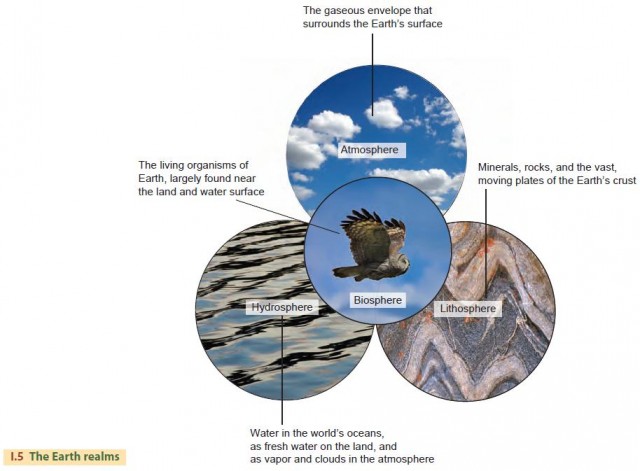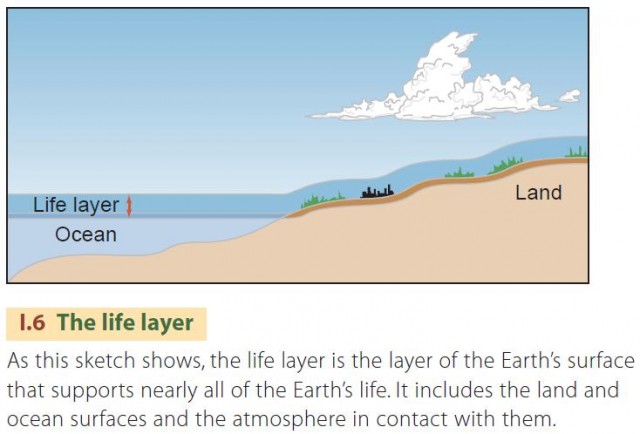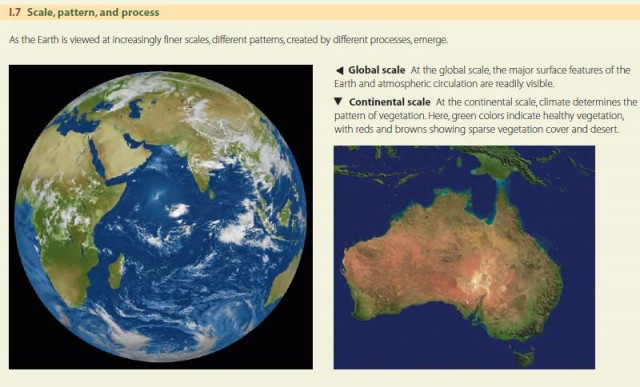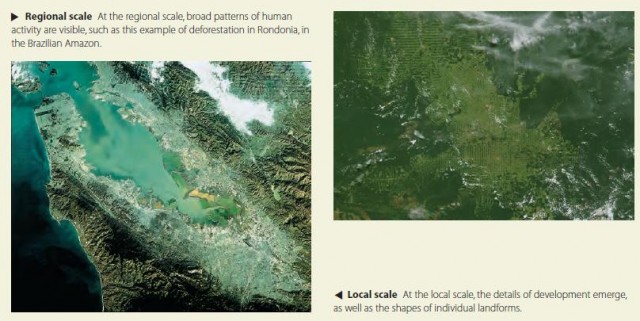Spheres, Systems, and Cycles
As a part of your introduction to physical geography, it will be useful to take a look at the big picture and examine some ideas that arch over all of physical geography—that is, spheres, systems, and cycles. The first of these ideas is that of the four great physical realms, or spheres of Earth—atmosphere, lithosphere, hydrosphere, and biosphere. These realms are distinctive parts of our planet with unique components and properties. Another big idea is that of systems—viewing the processes that shape our landscape as a set of interrelated components that comprise a system. The systems viewpoint stresses linkages and interactions and helps us to understand complex problems, such as global climate change or loss of biodiversity. The last big idea is that of cycles—regular changes in systems that reoccur through time.
THE SPHERES— FOUR GREAT EARTH REALMS
The natural systems that we will encounter in the study of physical geography operate within the four great realms, or spheres, of the Earth. These are the atmosphere, the lithosphere, the hydrosphere, and the biosphere (Figure I.5).
The atmosphere is a gaseous layer that surrounds the Earth. It receives heat and moisture from the surface and redistributes them, returning some heat and all the moisture to the surface. The atmosphere also supplies vital elements—carbon, hydrogen, oxygen, and nitrogen—that are needed to sustain life.

The outermost solid layer of the Earth, or lithosphere, provides the platform for most Earthly life-forms. The solid rock of the lithosphere bears a shallow layer of soil in which nutrient elements become available to organisms. The surface of the lithosphere is sculpted into landforms. These features—such as mountains, hills, and plains—provide varied habitats for plants, animals, and humans.
The liquid realm of the Earth is the hydrosphere, which is principally the mass of water in the world's oceans. It also includes solid ice in mountain and continental glaciers, which, like liquid ocean and fresh water, is subject to flow under the influence of gravity. Within the atmosphere, water occurs as gaseous vapor, liquid droplets, and solid ice crystals. In the lithosphere, water is found in the uppermost layers in soils and in ground water reservoirs.
The biosphere encompasses all living organisms of the Earth. Life-forms on Earth utilize the gases of the atmosphere, the water of the hydrosphere, and the nutrients of the lithosphere, and so the biosphere is dependent on all three of the other great realms. Figure I.6 diagrams this relationship.
Most of the biosphere is contained in the shallow surface zone called the life layer. It includes the surface of the lands and the upper 100 m or so (about 300 ft) of the ocean (Figure I.6). On land, the life layer is the zone of interactions among the biosphere, lithosphere, and atmosphere, with the hydrosphere represented by rain, snow, still water in ponds and lakes, and running water in rivers. In the ocean, the life layer is the zone of interactions among the hydrosphere, biosphere, and atmosphere, with the lithosphere represented by nutrients dissolved in the upper layer of sea water. Throughout our exploration of physical geography, we will often refer to the life layer and the four realms that interact within it.

SCALE, PATTERN, AND PROCESS
As we saw earlier, geographers have unique perspectives that characterize a geographic approach to understanding the physical and human organization of the Earth's surface. Three interrelated themes that often arise in geographic study are scale, pattern, and process. Scale refers to the level of structure or organization at which a phenomenon is studied. Pattern refers to the variation in a phenomenon that is seen at a particular scale. Process describes how the factors that affect a phenomenon act to produce a pattern at a particular scale.
To make these ideas more real, imagine yourself as an astronaut, returning to Earth from a voyage to the Moon. As you approach the Earth and finally touch down on land, your view of our planet takes in scales ranging from global to local. As the scale changes, so do the patterns and processes that you observe (Figure I.7).


At the global scale, you see the Earth's major physical features—oceans of blue water, continents of brown Earth, green vegetation, and white snow and ice, and an atmosphere of white clouds and clear air. The pattern of land and ocean is created by the processes of plate tectonics, which shape land masses and ocean basins across the eons of geologic time. The pattern of white clouds, which includes a band of persistent clouds near the Earth's equator and spirals of clouds moving across the globe, is created by atmospheric circulation processes that depend on solar heating coupled with the Earth's slow rotation on its axis. These processes act much more quickly and on a finer spatial scale than those of plate tectonics.
At the continental scale, we see the broad differentiation of land masses into regions of dry desert and
moister vegetated regions, a pattern caused by atmospheric processes that provide some areas with more precipitation than others. In some regions, air temperatures keep liquid water frozen, producing sea ice and glaciers. Air temperature and precipitation are the basic elements of climate, and so we may regard climate as a major factor affecting the landscape on a continental level.
At the regional scale, mountain ranges, deserts, lakes, and rivers create a varied pattern caused by interaction between geologic processes that raise mountains and lower valleys with atmospheric processes that provide water to run off the continents while supporting the growth of vegetation. Also evident at the regional scale are broad patterns of human activity, such as the deforestation of the Amazon (Figure 1.7C). Agricultural regions are clearly visible, distinguished by repeating geometric patterns of fields.
At the local scale, we zoom in on a landscape showing a distinctive pattern in fine detail. For example, our image of the San Francisco Bay region (Figure I.7D) reveals both the natural processes that carve hillslopes and canyons from mountain masses and the human processes that superimpose city and suburb on the natural landscape. At the finest scale, we see individual-scale landscape features, such as sand dunes, bogs, or freeways, each of which is the result of a different process.
These examples illustrate the themes of scale, pattern, and process as they apply to the landscapes of our planet. Keep in mind, however, that these themes are quite general ones. Throughout this book, we will see many examples of scale, pattern, and process applied to such diverse phenomena as climate, vegetation, soils, and landforms. We will zoom in and out, examining processes at local scales and applying them to regions to create and explain broad patterns observed at continental and global scales. In this way, you will gain a better understanding of how the Earth's surface changes and evolves in response to natural and human activities.
SYSTEMS IN PHYSICAL GEOGRAPHY
The processes that interact within the four realms to shape the life layer and differentiate global environments are varied and complex. A helpful way to understand the relationships among these processes is to study them as systems. “System” is a common English word that we use in everyday speech. It typically means a set or collection of things that are somehow related or organized. An example is the solar system—a collection of planets that revolve around the Sun. In the text, we will use the word “system” in this way quite often. Sometimes it refers to a scheme for naming things. For example, we will introduce a climate system in Chapter 7 and a soil classification system in Chapter 10. However, we will also use system to mean a group of interrelated processes that operate simultaneously in the physical landscape.
When we study physical geography using a systems approach, we look for linkages and interactions among processes. For example, global warming should enhance the process of evaporation of water from oceans and moist land surfaces, generating more clouds. But an increase in clouds also affects the process of solar reflection, in which white, fleecy clouds reflect solar radiation back out to space. This leaves less radiation to be absorbed by the atmosphere and surface and so should tend to cool our planet, reducing global warming. This is actually an example of negative feedback, in which one process counteracts another process to reduce its impact. Throughout the text there will be more examples of this systems viewpoint in physical geography.
TIME CYCLES
Many natural systems show time cycles—rhythms in which processes change in a regular and repeatable fashion. For example, the annual revolution of the Earth around the Sun generates a time cycle of incoming solar energy flow. We speak of this cycle as the rhythm of the seasons. The rotation of the Earth on its axis sets up the night-and-day cycle of darkness and light. The Moon, in its monthly orbit around the Earth, sets up its own time cycle, which we see in ocean tides.
The astronomical time cycles of Earth rotation and solar revolution appear at several places in our early chapters. Other time cycles with durations of tens to hundreds of thousands of years describe the alternate growth and shrinkage of the great continental ice sheets. Still others, with durations of millions of years, describe cycles of the solid Earth in which supercontinents form, break apart, and re-form anew.
- Introducing Geography
- physical geography
- What Climates and Weather Would Occur Here?
- How Does the Climate System Sustain Life?
- How Do We Use Computers to Study Climate Change?
- What Are the Consequences of Climate Change?
- What Factors Influence Climate Change?
- What Is the Evidence for Climate Change?
- How Does Air Quality Relate to Climate?